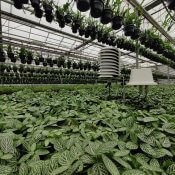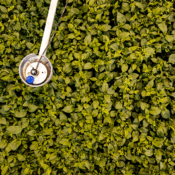Combine all data sources from your greenhouse for optimum cultivation results
Of course, you want to know exactly what is happening in your greenhouse, from the humidity level to the temperature of your crop. Nowadays, all of this information can be presented in a single dashboard on your smartphone or PC. Before digital tools like these were available, growers depended primarily on a reactive strategy. Thanks to green thumbs and decades of experience, this approach often produces a satisfactory result. Still, as a grower, you cannot always keep an eye on everything.
If you combine your experience with data sources, you reduce the risk of problems and know precisely when specific situations occur in your greenhouse. In order to switch to a proactive and risk-reducing approach, you will need to ensure that all the control devices and data sources in your greenhouse can communicate with each other. This is exactly what 30MHz’s data platform is all about.
What does this look like in practice?
Let us give an example: Zwinkels Agro B.V. produces aubergines and has a modern greenhouse spanning over 3.5 hectares in Monster, in the Dutch province of Zuid-Holland. Here, Angela Zwinkels runs her business with a team of highly qualified employees. As she is always interested in ways to optimise her production methods, she applied to 30MHz.
‘We use our climate computer and 30MHz sensors to measure greenhouse temperature, humidity, CO2, solar radiation and plant temperature,’ Angela explains. ‘This information is subsequently brought together in our 30MHz data platform. One of the greatest advantages to this is that it makes it easy to analyse and compare all the data collected and display and the relationships between the different variables.’
‘The system allows us to easily compare plant temperature to greenhouse temperature, for example. This helps us prevent condensation, which can cause mould on the crop.’
‘This becomes increasingly important as the season progresses. Another thing we measure is the effect of solar radiation on plant temperature.’
In this video, Angela explains what an average day in the greenhouse looks like.
Directly anticipating on unfavourable situations
Angela says that the system allows them to immediately anticipate on any unfavourable situations in relation to the crop. ‘Thanks to the platform and the sensors, it is very easy to trace and ultimately predict when, where and why certain situations occur in the crop. It lets us keep track of and see the climate conditions and settings at all times,’ confirms Angela.
All relevant data available at a glance on the 30MHz platform.
💡Did you know that you can measure humidity, dew point, VPD, plant temperature and radiation with only two 30MHz sensors? The Pointed Micro Climate sensor and PAR sensor give you all this data.
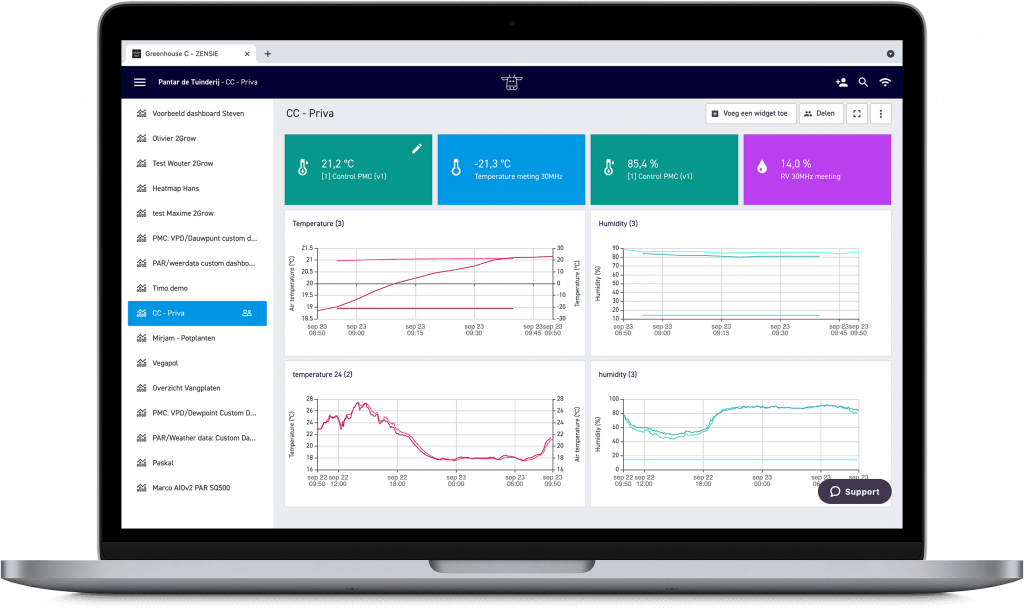
Higher production thanks to data analysis
Another good example is provided by green pepper grower Gubbels. When this company started making more serious use of sensors and data, production increased by 2.5 per cent. ‘We have been seeing far less sunscald on our green peppers ever since we were able to monitor our crops more accurately. Thanks to the data I analyse in the 30MHz platform, I know I can keep the windows closed longer. As a result, more humidity and CO2 are kept in the greenhouse, without the temperature becoming too high,’ says Geert Colbers, cultivation manager at Gubbels.
‘Thanks to the Pointed Micro Climate sensor, the number of scalded peppers has decreased, and production has increased because we can keep the screens open longer. Before we started using the 30MHz platform and the sensors, I always wanted to play it safe, using the methods on which I had always relied. Now, I am much more self-assured, and I dare to experiment more. I let more sunlight into the greenhouse, for example, to benefit optimally from the sun.’
Pointed Micro Climate sensor
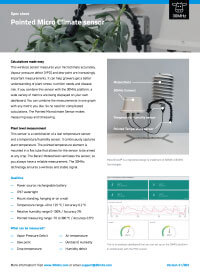
This sensor uses leaf temperature and temperature humidity measurements to continuously capture microclimate at close range. Use data from the sensor to better determine heating needs, cutting unnecessary energy expenditures and lowering the risk of plant fungus and disease.
A lot of our customers use this sensor for measuring VPD and dew point.
Charting the exact dew point
Similar to the cultivation of fruit and vegetables, there are many variables to take into consideration when you are growing flowers. Nico Plasmeijer grows calla lilies at BB Plant and explains how he combines data sources. ‘When we have watered the plants, we employ a strategy for aeration and heating.
‘Dew point can be determined even more accurately through the 30MHz platform. This cannot be done with a climate computer.’
You have to dry your greenhouse in a certain way, otherwise the plants will get too wet. 30MHz’s Pointed Micro Climate sensor displays the exact dew point. We always thought that we had already “tackled” the dew point issue correctly, but the data revealed that we had been too close to that dew point for too long. That is something a climate computer will not show,’
See also: Measuring crop-level dew point is not a myth
What is the dew point?
As unsaturated air cools down, it becomes increasingly saturated with water vapour. At a certain temperature, the air will become completely saturated. This temperature is what you call the dew point. Condensation occurs when the air is cooled down even further. When fruits, stems or other plant parts are colder than the dew point, they become wet from water vapour. These are ideal conditions for diseases such as fungi to develop. Fortunately, you can always see the exact dew point in the 30MHz platform.
Do you also want to benefit from digital horticulture?
There are still many opportunities in the field of digitization in horticulture. In the ebook we highlight 5 topics that we often encounter with our customers. Curious where your opportunities lie?
Ebook: 5 opportunities to benefit from digital horticulture
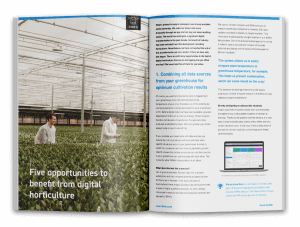
The digitization of horticulture offers great opportunities for energy-efficient cultivation. The use of sensor and climate data provides new insights to optimize cultivation.


30MHz is typing… Our extended support team is ready to chat!
At 30MHz we think it’s important that our users can use our platform in an optimal way. At times you may have questions and you would like some help from our support team. Email and our support page filled with helpful articles were your go to’s. But we thought it was time for something extra… ...Read more
New 30MHz connect casing: How we protect your tech
To make sure your dataflow is fully protected, 30MHz introduces a new connect casing: waterproof, dust proof and even resistant to hits. This special shield will last longer and ensure a reliable dataflow from the connected sensor. What does that full protection mean? That’s what we will explain in this article. Watertight: resistant to wetness ...Read more
Most popular sensors for your greenhouse
As a grower, you know that optimal crop development starts with precise monitoring of your cultivation environment. But how do you transform raw data into actionable insights for your crops? This is where our wireless sensors and the 30MHz platform come together. Our sensors measure essential variables such as VPD, dew point, moisture deficit, EC, ...Read more

